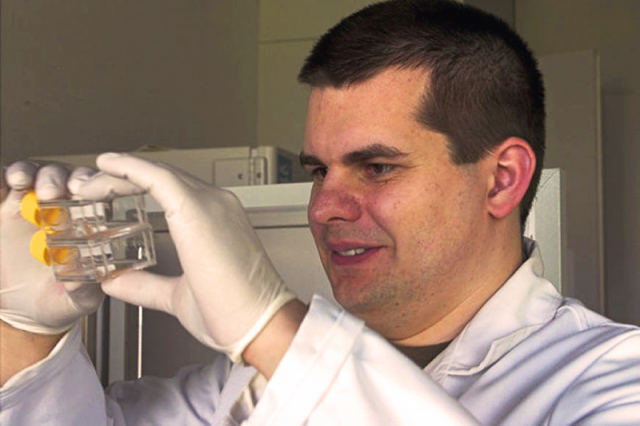Name: Gražvydas Lukinavičius
Current position: Group leader
Place: Max Planck Institute for Biophysical Chemistry in Göttingen, Germany.
Field of work/Research topic: Development and application of fluorescent probes targeting chromatin
What was your position and research topic with the NCCR Chemical Biology?
I joined Prof. Kai Johnsson’s group at the École polytechnique fédérale de Lausanne (EPFL) in 2008 as a postdoctoral researcher, which was before the creation of the NCCR Chemical Biology. In 2014, I got involved in one of the main research projects of the NCCR, which aims to develop new protein-based tools for addressing open questions in biology and medicine through visualization, characterization and manipulation of biochemical activities.
What was your career path after leaving the NCCR Chemical Biology?
During my stay at EPFL, I developed a successful collaboration with Prof. Stefan Hell, 2014 Nobel Prize laureate in Chemistry and one of the directors of the Max Planck Institute for Biophysical Chemistry in Göttingen, Germany. In 2016, he invited me to join his department as a postdoc. Two years after, I started my own group there.
To what do you attribute the success of your career path?
I am grateful to Vilnius University in Lithuania, which gave me a very strong theoretical knowledge of biochemical processes occurring in the cell. The NCCR Chemical Biology and the EPFL made it possible for me to apply this knowledge and played an essential role in the development of my scientific career.
What was the best or more exciting moment of your career until now?
The whole duration of my postdoctoral research at the EPFL – 8 years, quite a few – represents a very exciting time. I was collaborating with Keitaro Umezawa, a chemist at the University of Tokyo, and we observed that one of his fluorophores, the proprietary silicon-rhodamine (SiR), a bright and photostable rhodamine-like dye, displayed extremely interesting properties. I was able to switch the dye ON and OFF with the addition of sodium dodecyl sulfate – a detergent used in many cleaning and hygiene products. It turned out that this property is very useful and grants biocompatibility to the dye, which is important for the staining of living cells. Furthermore, this fluorescent dye was very useful for imaging living cells using super-resolution microscopy combining low cytotoxicity with excellent brightness. It was a really exciting moment, which led to several applications for imaging cell structures like chromatin, centrosomes, cytoskeleton, lysosomes and mitochondria.
What did you find unique about working/your collaboration with the NCCR Chemical Biology?
The NCCR Chemical Biology is a highly collaborative environment bringing together scientists from different disciplines, a fact that really motivates a lot of young researchers. At the beginning of its existence, the NCCR was focused on a few directions, but later, when more researchers joined its view widened leading to truly interdisciplinary research, and the number of collaborations between labs increased greatly.
What are the skills/expertise acquired with the NCCR Chemical Biology that are useful to you today?
During my eight years postdoc at the EPFL of which two years within the NCCR realm, I had a lot of interactions with researchers from Prof. Pierre Gönczy’s group. Its members are biologists with their own view of the biochemical processes happening in the cell. This different point of view was very useful in my research and I gained a lot of biological expertise from this collaboration. I am still applying these skills in my research today combining chemistry, biology and microscopy techniques.
Do you have any advice to give to current NCCR members who are interested in your professional career?
Make collaborations. Listen to researchers from other laboratories and disciplines. This requires tolerance and patience. By doing this, you will gain invaluable knowledge.
 Gražvydas Lukinavičius received his PhD in Biochemistry at the Vilnius University, Institute of Biotechnology in 2007, and received the best PhD Thesis Award in the field of physical, technological and biomedical sciences in Lithuania. For postdoctoral studies, he moved to Prof. Kai Johnsson’s group at EPFL and was supported by a FEBS long-term fellowship. In 2016, he was invited by Prof. Stefan Hell to join the Max Planck Institute for Biophysical Chemistry and received a Nobel Laureate fellowship from Max Planck Society. He recently started his own group, which focuses on chromatin labeling and imaging. His research is focused on the development of fluorescent chromatin probes to reveal structure and dynamics of the genetic material.
Gražvydas Lukinavičius received his PhD in Biochemistry at the Vilnius University, Institute of Biotechnology in 2007, and received the best PhD Thesis Award in the field of physical, technological and biomedical sciences in Lithuania. For postdoctoral studies, he moved to Prof. Kai Johnsson’s group at EPFL and was supported by a FEBS long-term fellowship. In 2016, he was invited by Prof. Stefan Hell to join the Max Planck Institute for Biophysical Chemistry and received a Nobel Laureate fellowship from Max Planck Society. He recently started his own group, which focuses on chromatin labeling and imaging. His research is focused on the development of fluorescent chromatin probes to reveal structure and dynamics of the genetic material.


Leave a comment
The editors reserve the right not to publish comments or to abridge them.